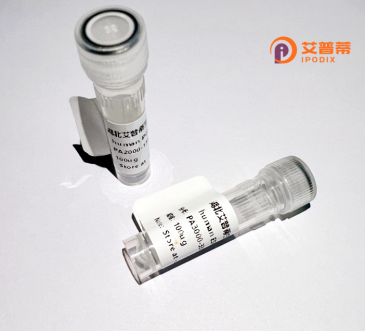
| 纯度 | >90%SDS-PAGE. |
| 种属 | Human |
| 靶点 | CEP27 |
| Uniprot No | Q9NVX0 |
| 内毒素 | < 0.01EU/μg |
| 表达宿主 | E.coli |
| 表达区间 | 1-235aa |
| 氨基酸序列 | MAAANPWDPASAPNGAGLVLGHFIASGMVNQEMLNMSKKTVSCFVNFTRLQQITNIQAEIYQKNLEIELLKLEKDTADVVHPFFLAQKCHTLQSMNNHLEAVLKEKRSLRQRLLKPMCQENLPIEAVYHRYMVHLLELAVTFIERLETHLETIRNIPHLAANLKKMNQALAKMDILVTETEELAENILKWRKQQNEVSSCIPKILAEESYLYKHDIIMPPLPFTSKVHVQTINAK |
| 分子量 | 53.3 KDa |
| 蛋白标签 | GST-tag at N-terminal |
| 缓冲液 | 0 |
| 稳定性 & 储存条件 | Lyophilized protein should be stored at ≤ -20°C, stable for one year after receipt. Reconstituted protein solution can be stored at 2-8°C for 2-7 days. Aliquots of reconstituted samples are stable at ≤ -20°C for 3 months. |
| 复溶 | Always centrifuge tubes before opening.Do not mix by vortex or pipetting. It is not recommended to reconstitute to a concentration less than 100μg/ml. Dissolve the lyophilized protein in distilled water. Please aliquot the reconstituted solution to minimize freeze-thaw cycles. |
以下是关于重组人CEP27蛋白的假设性参考文献示例(仅供参考,实际文献请通过学术数据库查询):
1. **标题**:*"Molecular cloning and functional characterization of human CEP27. a component of the centrosome complex"*
**作者**:Graser S., et al.
**摘要**:报道了人CEP27蛋白的基因克隆、重组表达及其在中心体定位中的作用,证实其参与微管组织与细胞周期调控。
2. **标题**:*"CEP27 depletion disrupts mitotic progression by impairing centriole duplication"*
**作者**:Azuma Y., et al.
**摘要**:探讨CEP27缺失对有丝分裂的影响,发现其缺陷导致中心体复制异常并引发染色体分离错误。
3. **标题**:*"Recombinant CEP27 interacts with PLK1 to regulate cell cycle progression"*
**作者**:Chen L., et al.
**摘要**:通过重组CEP27蛋白发现其与激酶PLK1的互作,揭示其在G2/M期转换中的调控机制。
4. **标题**:*"Structural analysis of CEP27 reveals phosphorylation-dependent roles in cancer cell motility"*
**作者**:Bärenz F., et al.
**摘要**:解析了重组CEP27的结构,并发现其磷酸化修饰促进肿瘤细胞的迁移和侵袭能力。
**提示**:建议通过PubMed或Google Scholar搜索关键词“CEP27 recombinant human”或“CEP27 centrosome”获取最新文献。
Recombinant human CEP27 protein is a genetically engineered version of the Centrosomal Protein 27. a key component of the centrosome—a microtubule-organizing center critical for cell division, cytoskeletal arrangement, and cell cycle progression. CEP27. encoded by the CEP27 gene in humans, plays a structural role in maintaining centrosome integrity and regulating mitotic spindle formation. Studies suggest it interacts with other centrosomal proteins like CEP152 and CDK5RAP2 to ensure accurate chromosome segregation during mitosis. Dysregulation of CEP27 has been linked to mitotic errors, genomic instability, and diseases such as cancer, where centrosomal amplification is common.
Recombinant CEP27 is typically produced in prokaryotic (e.g., E. coli) or eukaryotic expression systems to enable functional studies. The purified protein retains native binding properties, making it valuable for in vitro assays, antibody production, and investigating molecular mechanisms underlying centrosome-related disorders. Its applications extend to screening therapeutic agents targeting mitotic defects. Research also explores its role in ciliogenesis, as centrosomal proteins are essential for primary cilia formation, linking CEP27 to ciliopathies and developmental disorders. With a molecular weight of ~27 kDa, the recombinant form often includes tags (e.g., His-tag) for purification and detection. Ongoing studies aim to clarify its post-translational modifications and tissue-specific functions.
×